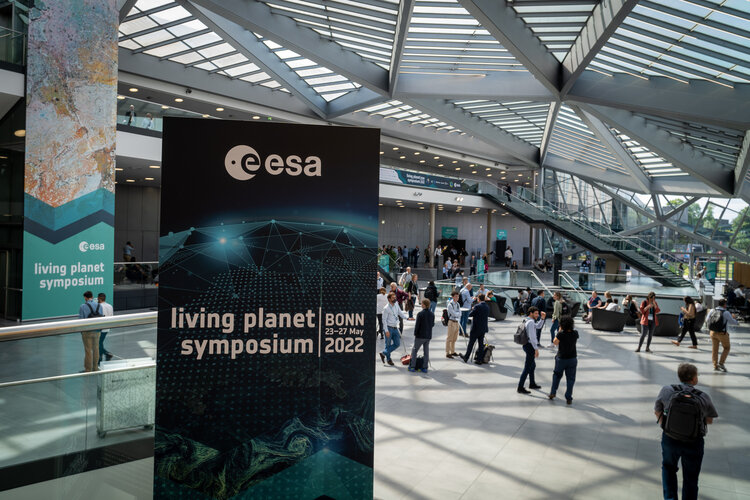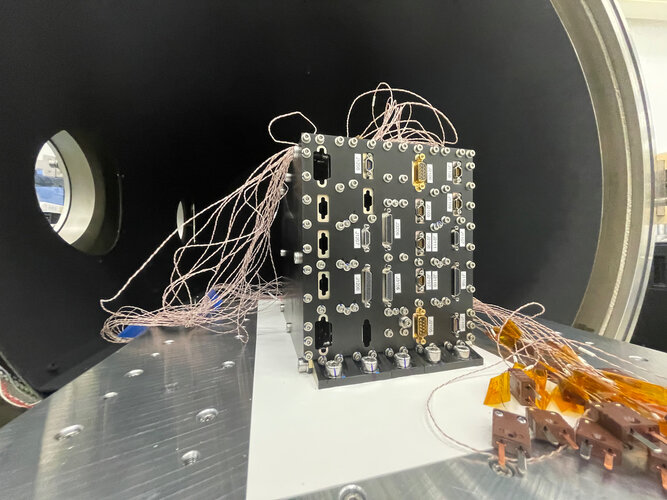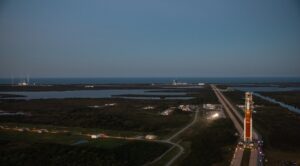Post-flight interview with Matthias Maurer | Cosmic Kiss
Monday, 30 May 2022 11:00 Video:
00:07:10
Video:
00:07:10
Interview with ESA astronaut Matthias Maurer after the conclusion of his 177-day mission on the International Space Station. During his time in orbit, Matthias supported over 35 European experiments and even more international experiments on board. The outcomes of these experiments will advance our knowledge in areas ranging from human health to materials science, benefiting life on Earth and the future of space exploration. Other highlights included his spacewalk to improve and maintain the Space Station. More about the Cosmic Kiss mission: https://www.esa.int/cosmickiss
Revisit Living Planet Symposium: watch session replays
Monday, 30 May 2022 08:00
Revisit Living Planet Symposium: watch session replays
AFRL sponsorship recipient wins NASA space manufacturing contract
Monday, 30 May 2022 07:47 Air Force Research Laboratory research sponsorship recipient, United Semiconductors, LLC (USLLC), is one of eight companies selected to work on a three-year, $21 million NASA contract to manufacture tools in space.
Almost two decades ago, AFRL's photonic materials branch began collaborating with Professor Partha Dutta at the Rensselaer Polytechnic Institute and sponsoring his research on t
Air Force Research Laboratory research sponsorship recipient, United Semiconductors, LLC (USLLC), is one of eight companies selected to work on a three-year, $21 million NASA contract to manufacture tools in space.
Almost two decades ago, AFRL's photonic materials branch began collaborating with Professor Partha Dutta at the Rensselaer Polytechnic Institute and sponsoring his research on t Space Systems Command Issues Launch Task Orders for FY22 NSS Missions
Monday, 30 May 2022 07:47 Space Systems Command (SSC) ordered eight National Security Space (NSS) launch services under the National Security Space Launch (NSSL) Phase 2 Launch Service Procurement contract Friday; five to United Launch Alliance (ULA) for GPS III-7, USSF-23, USSF-43, WGS-11+, and USSF-16 using the Vulcan Centaur launch vehicle, and three to Space Exploration Technologies Corp (SpaceX) for USSF-124, USSF-6
Space Systems Command (SSC) ordered eight National Security Space (NSS) launch services under the National Security Space Launch (NSSL) Phase 2 Launch Service Procurement contract Friday; five to United Launch Alliance (ULA) for GPS III-7, USSF-23, USSF-43, WGS-11+, and USSF-16 using the Vulcan Centaur launch vehicle, and three to Space Exploration Technologies Corp (SpaceX) for USSF-124, USSF-6 AI and machine learning are improving weather forecasts, but they won't replace human experts
Monday, 30 May 2022 07:47 A century ago, English mathematician Lewis Fry Richardson proposed a startling idea for that time: constructing a systematic process based on math for predicting the weather. In his 1922 book, "Weather Prediction By Numerical Process," Richardson tried to write an equation that he could use to solve the dynamics of the atmosphere based on hand calculations.
It didn't work because not enoug
A century ago, English mathematician Lewis Fry Richardson proposed a startling idea for that time: constructing a systematic process based on math for predicting the weather. In his 1922 book, "Weather Prediction By Numerical Process," Richardson tried to write an equation that he could use to solve the dynamics of the atmosphere based on hand calculations.
It didn't work because not enoug DLR presents technologies for decarbonisation across the economy
Monday, 30 May 2022 07:47 The German Aerospace Center will be presenting technologies, innovations and successful transfer and spin-off projects at Hannover Messe 2022. From 30 May to 2 June, at the 120-square-metre stand (Energy Solutions, Hall 13, D18), visitors will be able to gain an insight into DLR's research for a future climate-friendly energy supply system and for the decarbonisation of industrial processes and
The German Aerospace Center will be presenting technologies, innovations and successful transfer and spin-off projects at Hannover Messe 2022. From 30 May to 2 June, at the 120-square-metre stand (Energy Solutions, Hall 13, D18), visitors will be able to gain an insight into DLR's research for a future climate-friendly energy supply system and for the decarbonisation of industrial processes and Tiny robotic crab is smallest-ever remote-controlled walking robot
Monday, 30 May 2022 07:47 Northwestern University engineers have developed the smallest-ever remote-controlled walking robot - and it comes in the form of a tiny, adorable peekytoe crab.
Just a half-millimeter wide, the tiny crabs can bend, twist, crawl, walk, turn and even jump. The researchers also developed millimeter-sized robots resembling inchworms, crickets and beetles. Although the research is exploratory a
Northwestern University engineers have developed the smallest-ever remote-controlled walking robot - and it comes in the form of a tiny, adorable peekytoe crab.
Just a half-millimeter wide, the tiny crabs can bend, twist, crawl, walk, turn and even jump. The researchers also developed millimeter-sized robots resembling inchworms, crickets and beetles. Although the research is exploratory a Vacuum soak for satellite brain
Monday, 30 May 2022 06:16 Image:
Vacuum soak for satellite brain
Image:
Vacuum soak for satellite brain Next SLS countdown rehearsal scheduled for June 19
Monday, 30 May 2022 01:20
NASA has tentatively scheduled the next attempt to fuel the Space Launch System and go through a practice countdown for June 19, two weeks after the vehicle returns to the launch pad.
Why Did Mars Dry Out? New Study Points To Unusual Answers
Sunday, 29 May 2022 10:47 Mars once ran red with rivers. The telltale tracks of past rivers, streams and lakes are visible today all over the planet. But about three billion years ago, they all dried up - and no one knows why.
"People have put forward different ideas, but we're not sure what caused the climate to change so dramatically," said University of Chicago geophysical scientist Edwin Kite. "We'd really like
Mars once ran red with rivers. The telltale tracks of past rivers, streams and lakes are visible today all over the planet. But about three billion years ago, they all dried up - and no one knows why.
"People have put forward different ideas, but we're not sure what caused the climate to change so dramatically," said University of Chicago geophysical scientist Edwin Kite. "We'd really like Up, Up and Away - Sols 3487-3490
Sunday, 29 May 2022 10:47 Our intrepid rover engineers again successfully navigated Curiosity a little higher up Mount Sharp (~5 m) and ~40 m on the ground, away from our previous location. The terrain beneath the rover included striated, dusty bedrock and sand ripples with coarse lag deposits.
As a member of the geology/mineralogy planning team and the APXS payload uplink lead today, I chose several interesting ar
Our intrepid rover engineers again successfully navigated Curiosity a little higher up Mount Sharp (~5 m) and ~40 m on the ground, away from our previous location. The terrain beneath the rover included striated, dusty bedrock and sand ripples with coarse lag deposits.
As a member of the geology/mineralogy planning team and the APXS payload uplink lead today, I chose several interesting ar New meteor shower? How many meteors will I see, really?
Sunday, 29 May 2022 10:47 Astronomers are excited about the possibility of a new meteor shower May 30-31. And that excitement has sparked a lot of information about the tau Herculids. Some has been accurate, and some has not.
We get excited about meteor showers, too! But sometimes events like this don't live up to expectations - it happened with the 2019 Alpha Monocerotid shower, for example. And some astronomers p
Astronomers are excited about the possibility of a new meteor shower May 30-31. And that excitement has sparked a lot of information about the tau Herculids. Some has been accurate, and some has not.
We get excited about meteor showers, too! But sometimes events like this don't live up to expectations - it happened with the 2019 Alpha Monocerotid shower, for example. And some astronomers p Commercial Space Exec: Hands-On Work Can Launch Careers
Sunday, 29 May 2022 10:47 Tyler Grinnell ('08) worked at Kennedy Space Center while he was still an Aerospace Engineering student at Embry-Riddle, juggling a full load of classes.
"That was a dream come true for me to be able to work on the space shuttle program while I was just out of my sophomore year," he said, at the university's latest Presidential Speaker Series event.
That real-world experience propell
Tyler Grinnell ('08) worked at Kennedy Space Center while he was still an Aerospace Engineering student at Embry-Riddle, juggling a full load of classes.
"That was a dream come true for me to be able to work on the space shuttle program while I was just out of my sophomore year," he said, at the university's latest Presidential Speaker Series event.
That real-world experience propell OneWeb satellite to be deorbited at the end of its active lifetime
Sunday, 29 May 2022 10:47 The world's first mission to remove several small telecommunications satellites from orbit once they reach the end of their operational service is about to start building and testing its prototype spacecraft.
British-based in-orbit servicing company Astroscale - working in an ESA Partnership Project with satellite operator OneWeb - will begin manufacturing the first commercial "servicer" p
The world's first mission to remove several small telecommunications satellites from orbit once they reach the end of their operational service is about to start building and testing its prototype spacecraft.
British-based in-orbit servicing company Astroscale - working in an ESA Partnership Project with satellite operator OneWeb - will begin manufacturing the first commercial "servicer" p 
